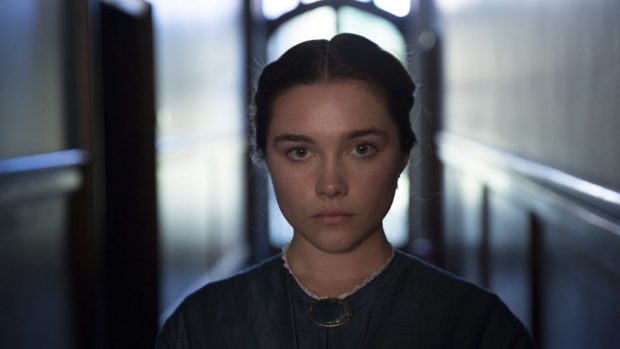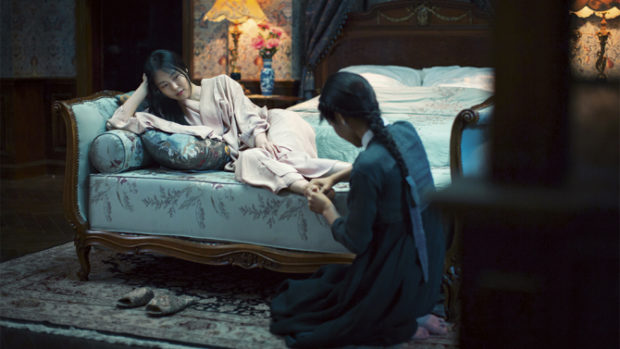You have no items in your cart. Want to get some nice things?
Go shopping
It’s an old adage in the world of book lovers: the book is always better than the film. To suggest otherwise (as in the case of, for instance, Starship Troopers, the film of which is much more economically paced than the book) is to court controversy and possibly even denouncement as a heresiarch. But what about films that are only barely adaptations of books, films that become a quite separate piece of art in their own right? Is it even worth comparing them to their source material? How can we do that in a way that helps us to appreciate them for what they are, instead of condemning them for what they aren’t?
Lady Macbeth and The Handmaiden, two of the films shown at the London Film Festival this year, both fall into this category. Lady Macbeth, despite its title, has nothing (at least, nothing concrete) to do with the Shakespeare play; it’s an adaptation of the Russian novella Lady Macbeth of Mtsensk by Nikolai Leskov, which was also made into an opera by Shostakovich. The Handmaiden, meanwhile, is a Korean reimagining of Sarah Waters’s novel Fingersmith, a sort of Victorian heist thriller with a tender same-sex romance at its core and one of the top five best plot twists I’ve ever read.
Lady Macbeth is especially interesting because it has allusions to two separate works of literature folded into its core. As a film version of Lady Macbeth of Mtsensk, it sticks fairly closely to its source material, with the exception of some of the names: here, the horrible father-in-law is still named Boris, but characters such as Vinovy and Sergei become Alexander and Sebastian. Wherever we are—and the film is always coy on its precise geography—we’re not in Russia. Where the film does take a leap into new territory, though, is in its quiet acknowledgment of interracial history: Sebastian, the servant for whom our protagonist Katherine commits adultery and murder, is black, as is Katherine’s personal maid, Anna. There’s no mention of this in the film script; it’s just there, ever-present, unavoidably affecting the way a viewer interprets Katherine’s actions. Her struggle to find a way out of imprisonment, lovelessness and oppression engages our sympathies, but her exit strategy involves ruthlessly using the people of colour who surround her. The accusations commonly levelled at what’s referred to as “white feminism”—that it excludes and oppresses women of colour, poorer women, anyone who doesn’t fit a narrow band of criteria—draw their strength from the historical reality of behaviour like Katherine’s.
The second work to which Lady Macbeth refers is, of course, the notorious Scottish Play. It’s an oblique reference; Lady Macbeth of Mtsensk is seemingly so called only because it involves a woman who plots murder. At first glance, this looks like a bit of a stretch. The original Lady M. kills in pursuit of power, and not even direct power, but the indirect thrill of being intimately connected to (and perhaps able to manipulate) a powerful man. Katherine’s motive looks very different: she kills more emotionally, to free herself from a loveless marriage. What Lady Macbeth does as a film is allow us to ask ourselves whether these motives are more similar than they appear: to liberate oneself into the life one wants is a power not to be underestimated.

There are political undertones, too, in The Handmaiden. Park Chan-wook relocates the action from Victorian Britain to Japanese-occupied Korea in the 1930s. His “handmaiden”—the woman recruited to pose as a maid to a wealthy lady, while actually helping a con man to seduce her, steal her fortune, and have her committed—is Korean; the lady, and her rich uncle, are Japanese. But this kind of resistance and rebellion isn’t Park’s main focus. Instead, with great respect for the emotional and erotic intensity of his source material in Fingersmith, he gives us a story about two young women whose feelings for each other allow them to explore a world where the men who surround and menace them become irrelevant. The Guardian review of this film notes that it paints male physicality and sexuality as faintly distasteful: “Men are pathetic, unwanted voyeurs.” It’s a smart way of side-stepping the problem of a man making a movie about lesbian romance: render the male gaze silly, not worth noticing. The context of a piece of art—the question of who is making it, and what perspective they might be approaching the subject from—can change its meaning. Park ensures that his film doesn’t suffer from the fact that he is neither a woman nor gay, by privileging his characters’ experience instead of imposing his own ego onto the project.
Both Lady Macbeth and The Handmaiden are well worth seeing if you enjoyed their source material, but are equally accessible if you’re coming to these stories fresh. (I’ve never read Lady Macbeth of Mtsensk; it didn’t matter.) The London Film Festival, once again, proves what an incredible resource it is for connoisseurs and novices alike to experience beautiful, thought-provoking works of cinematic art.

About Eleanor Franzen
Eleanor Franzén is a London-based writer and editorial assistant. She blogs about books at Elle Thinks (https://www.ellethinks.wordpress.com).




